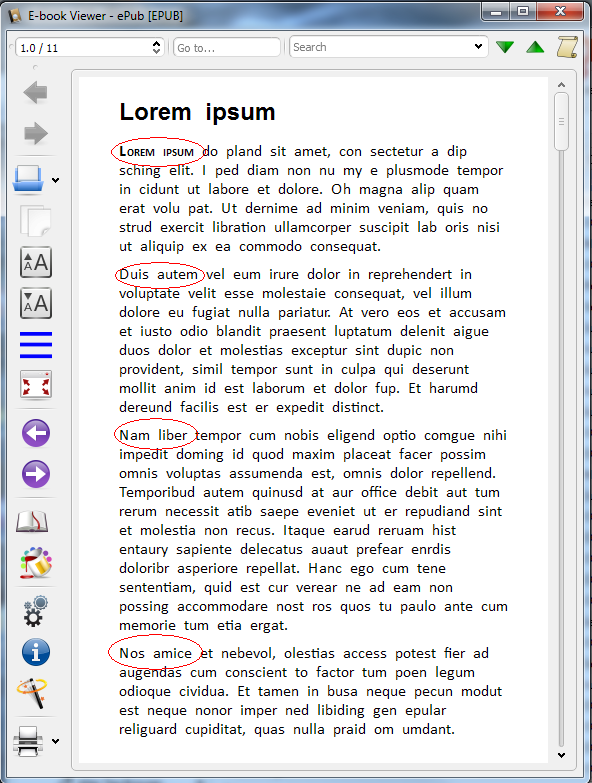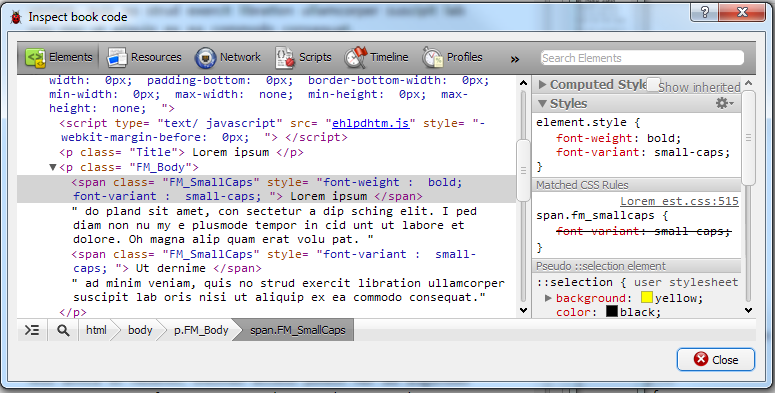- Home
- FrameMaker
- Discussions
- What's required to get small caps to an epub? (Fra...
- What's required to get small caps to an epub? (Fra...
What's required to get small caps to an epub? (Frame 12)
Copy link to clipboard
Copied
In Frame 12, I started with the standard template for the User Guide and have put all chapters in the one file. Then I successfully published to epub and HTML5.
- Both files show the blue chapter number across the top of the chapter.
- Both files show the different paragraph style for the first paragraph following each new chapter (now temporarily identified with Heading1)
- Neither file shows the running headers or footers. Can I change this?
- Only the HTML5 shows the small caps Character Tag with which the first words of each new chapter are tagged.
Advice for correcting the last two points?
Thanks in advance.
Copy link to clipboard
Copied
Typically running headers/footers (navigation aids) aren't used in ePubs and HTML5 as the concept of a "page" depends upon the user's device and/or output specifications and there are different navigation aids available. You can create custom templates (HTML Page Template on the Outputs > General tab) , however, and import one of those to provide background content, images, etc.
For the small caps, it might be a function of the device or epub viewer that you're using. Here's a dummy file where the first two words of every paragraph are tagged with a small cap attribute. The first paragraph also has a Bold/Heavy attribute applied to the first two words. The left version is from Sigil and he right one is using Calibre for the same ePub file.


Welcome to the world of ePub (un)certainy. Much like the browser wars, you won't know how something will display in a particular eReader or ePub reading application until you try it.
Copy link to clipboard
Copied
Arnis, I don't suppose there is one location to look up all the discrepancies? ![]()
I do know that I've read ebooks on my Nook which have a background header. Any idea where I'd go look this up?
Thanks,
Theresa
Copy link to clipboard
Copied
You could contact Scott Prentice at Leximation about what various eReaders support. He's given many presentations at STC meetings on the topic of ePubs.
For info about background stuff, search on RoboHelp master pages and HTML page templates.
Copy link to clipboard
Copied
Might also have a look at this thread - https://forums.adobe.com/thread/857360?q=epub
Copy link to clipboard
Copied
Jeff, that link was to
Advice on using RH's ePub Format & Mobile Device Help
which doesn't appear to have much to do with Frame 12 ePub and discusses the need of mobile help rather than ebook readers.
Copy link to clipboard
Copied
I know – all the guts of the FM publishing “stuff” is from RH – it was more the links mentioned within some of the posts that were of interest.
Copy link to clipboard
Copied
Not surprising, Jeff, that the epub links would be from RH since Frame didn't have the ability before now. However, some of the links on that post no longer work and others are about mobile help, so I don't know what I'm not seeing.
I'm looking to find out what I'll need to do to the Frame document to make the output acceptable to various ereaders. Can this be done inside the Frame document?
Copy link to clipboard
Copied
Arnis and Jeff, thanks for the info.
Arnis, what did you do to make the first two words have small caps? Did you program the body paragraph tag in some way? I manually applied the Character tag.
Copy link to clipboard
Copied
As I mentioned, the first paragraph's first two words also had second character tag applied that used a Heavy variant of the font (Cambria), Here's how the elements look when inspected in detail within the respective apps (first Sigl and then Calibre):


Notice how in Calibre, it's not liking the small-caps span and stroking out the CSS rule.
Copy link to clipboard
Copied
Hi Arnis. What is the relationship between Frame and looking at the document in Sigil or Calibre?
Copy link to clipboard
Copied
The generated ePub output is being viewed by these two ePub reading applications and there is no absolutely no relationship between FM and these.
The ePub rendering agents are all over the place in terms of their capabilities and what level of ePub and CSS features that they support.
Copy link to clipboard
Copied
Arnis, sorry if I'm dense.
Are you saying that in order to get reliable output (i.e. predictable epub behaviour) that it cannot be done with a Frame document?
Copy link to clipboard
Copied
Hi All...
The only way to get reasonably consistent EPUB output is to strip the styling down to the bare minimum. Each reader and platform will have subtle differences in the way they interpret formatting properties, so the less there is to interpret, the fewer differences you'll run into. In my opinion, for the Techcomm world, you should be focusing on the content, and not focusing on providing special formatting. This may be different for "retail" books which may have more of a focus on the art of how the "page" is formatted. Again .. that's just my opinion.
FrameMaker (via the RoboHelp engine) does some strange things to the underlying HTML (this is true for all HTML-based output from FM/RH). It tends to generate HTML that uses a mix of CSS classes and hard-coded style attributes. In the example that Arnis provided, you see a classic example ..
<span class="FM_SmallCaps" style="font-weight : bold; font-variant : small-caps; ">
WHY is the style attribute needed? This essentially overrides the font-weight and font-variant properties that may be defined by the CSS class of FM_SmallCaps .. negating the efficiency of using CSS. This is especially problematic for tables and lists, and makes them work very poorly on a small screen. It will often be trying to emulate properties assigned in the FM document (likely a page-based presentation of a fixed size), and using that for the online formatting of varying sizes. This is bad.
I haven't done enough testing to see how to overcome this problem using only FrameMaker (or RH). It may be that the style properties are passed on if you apply style overrides to the content in Frame. I think this is part of the problem, so if you avoid that practice (which is bad anyway), you may be a bit better off, but it does not eliminate the problem.
In order to understand this problem fully, you have to carefully review the HTML markup that is being generated by FM/RH. (Note that this forum is specific to Adobe products, so that's what we're talking about here .. but this problem exists for ALL techcomm tools that I've tested, so it's not a matter of choosing another tool.) In order to review the underlying HTML, you need to use a tool that lets you open up the generated EPUB and look at the files. Calibre and Sigil are two tools that can do this (both are free) .. I prefer to use Oxygen XML Editor, because it is a powerful XML editor that lets you make global changes to the files in the EPUB, much better than other tools. It also lets you run the epubcheck validator within the interface and lists all problems which are easily accessible to review and locate.
When I use FM/RH to generate an EPUB, I open up the resulting EPUB and strip out all style attributes .. everywhere. Then you can rely on the CSS classes to control the formatting. This will help with the reader inconsistencies, but even with that you'll see some. The solution is to eliminate the formatting that seems flaky or just live with the inconsistencies.
There is a website called EPUB Test (http://epubtest.org) that provides examples of reader inconsistencies. Good place to visit.
But the bottom line is that if you're using special formatting in your EPUB, you'll need to test on as many readers as possible. When I say "special" formatting, I mean pretty much anything. Unless the HTML in your EPUB looks like HTML from the early 90s (H1, H2, P, B, I, .. you get the idea), it's up for interpretation by various readers, and you should know how it looks to your customers. Document which readers have been tested and encourage your users to report back on any issues they run into.
NEVER just generate an EPUB and ship it to your users without testing in multiple readers.
If you're interested in seeing some of the slides from presentations I've given on this subject, as well as articles for STC Intercomm and TCWorld magazines, visit this page on my website ..
http://leximation.com/aboutscott.php#PRESENTATIONS
Cheers!
…scott
Copy link to clipboard
Copied
Thanks Scott for your sage advice on the state of the art (or rather, the lack of consistency) in ePub output. Your web page has quite a number of excellent presentations on this topic that should be referenced by anyone planning to undertake ePub generation via FM.
Copy link to clipboard
Copied
Scott, thanks for all those links. I've been reading away all day...
Sorry that my questions come out one at a time, but they do:
The Frame 12 dialogue box for "Publish" comes up with 5 options and a 6th (all of the 5). I've been watching Frame 12 seminars and imagining that there's a way to structure the document so that it will work for all 5 options. But, based on your post, this is not sensible. Formatting for print and epub should be in different documents...
Am I understanding this right?
Thanks.
Copy link to clipboard
Copied
Formatting for an EPUB should be simpler than for print .. but there's no reason that you can't use the same source for both (in a perfect world). If FM/RH was just applying a class for each style (para or character), then your CSS can control what styling is applied (if any) for each. But because the style attributes are scattered throughout, you have no easy way to do that since those will apply formatting regardless of the CSS definition.
It really depends on the resources that are available to you. It's fairly "easy" to write a script to strip out the style attributes, but that does require that you're either using something like Oxygen to do cleanup on the EPUB, or you're dissembling the EPUB and running scripts on it, then reassembling it (and you have the resources to write the script). Either way it's a lot of hoops to jump through. An alternative option would be to set up a workflow where you save your FM files to a new location, and strip out much of the formatting, then Publish that to EPUB. You will still have style attributes in tables and possibly lists .. but it depends on what you're creating and what's important.
Remember to run the EPUB through the epubcheck validator. You can hook that up to the FM Publish process, but also make sure to re-validate if you make any tweaks afterwards.
Does that help?
…scott
Copy link to clipboard
Copied
Omitting the RH, how do I tell what Frame is using as its CSS? Or do I need to go to Sigil and Calibre to find out?
Copy link to clipboard
Copied
I don't know. I'm sure there's a better way but I just crack open the EPUB to see .. there are typically a number of CSS files (too many from my perspective). Maybe someone else can provide info on the CSS usage.
Note that Sigil is not EPUB 3 compliant .. it'll open EPUB 3 files, but it may not handle the EPUB 3 specific features (not that there are many to worry about in FM-generated EPUBs though). I don't know where Calibre stands in this regard.
…scott
Copy link to clipboard
Copied
Theresa,
The ePub file is just a zip container so you can open it with any zip utility, like 7z or WinZip. The CSS file being used for rendering the published document will be found in the \OEBPS folder and will have the same name as the ePub file, e.g. for myBook.epub look for \OEBPS\myBook.css
If you want a fairly robust ePub3 viewer to check your files, try the Azardi reader available at: Download AZARDI - AZARDI@IGP (this one seems to render the Small Caps as expected).
For editing ePubs, besides using OxygenXML, there also is the BlueGriffon EPUB Edition
Addendum: apparently, one can also use Adobe's Dreamweaver as an ePub editor. See: Dreamweaver as ePub Editor | Digital Publishing with Adobe InDesign
Copy link to clipboard
Copied
Hi,
However, be careful with ePub 3 features. As you can see on http://epubtest.org all ePub viewers support only a subset o ePub 3. And most of your users will not have the latest viewers but old ones!
Copy link to clipboard
Copied
@Winfried .. that's a good point, but note that there are effectively no EPUB 3 features in the EPUBs produced by FM/RH, so the only way to get those features would be to manually add them yourself. I hope that future FM/RH updates will allow you to include EPUB 3 features, but at this point that's not a concern.
Copy link to clipboard
Copied
@Scott – isn’t this easier to fine tune if you run it through the traditional FM to RH route? I think Matt Sullivan described this in his blog post (http://www.mattrsullivan.com/blog/tcs/ebooks/) when he was formatting his FM bible for ePUB.
Copy link to clipboard
Copied
Jeff, my version of RH is so old, it predates its ownership by Adobe.
Part of the reason I upgraded to Frame 12 was for epub publishing.
So, for both these reasons, I'm not going to be publishing via RH. Also, instructions that include RH don't further my understanding of the issues. (Though it may help others).
Copy link to clipboard
Copied
That’s cool – just to let you know that the “publishing” features of FM (which started before FM12 BTW) have been pretty “raw” – which makes sense because FM was never initially designed to be a HAT-type help-content generator. All the “guts” have been lifted from the TCS RH engine – which lets you “pop the hood” and really mess around with the results much more. I suspect eventually FM will allow this level of tinkering to be exposed.
-
- 1
- 2
Find more inspiration, events, and resources on the new Adobe Community
Explore Now